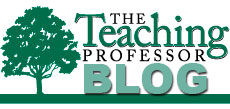Editor’s Note: Today we feature part 2 of Dr. Greenstreet’s “10-Point Survival Guide to Being, and Staying, an Academic Leader.” If you missed part 1, please click here for yesterday’s post.
Read more ›CURRENT ARTICLE • March 04
OTHER RECENT ARTICLES
While entering the administrative ranks of academia might seem a formidable task, staying there presents a whole other series of challenges. The average length of stay for a dean, vice chancellor, or chancellor can often be fewer than five years and in some programs, the duration of leadership has been known to be considerably shorter.
Read More › Occasionally we need a reminder like this: based on a thorough literature review, Paul Ramsden, a noted researcher on teaching and learning, along with several co-authors offered this description of good teachers.
Occasionally we need a reminder like this: based on a thorough literature review, Paul Ramsden, a noted researcher on teaching and learning, along with several co-authors offered this description of good teachers.
When learners reflect, they thoughtfully consider (or reconsider) an experience. If the reflection is critical, it challenges the customary ways of understanding or explaining an experience. Critical reflection questions meanings and looks at assumptions. The opportunity to reflect on experiences develops critical thinking skills and helps students to learn things for themselves.
Read More ›Personnel review binders used for retention, promotion, and tenure decisions may go the way of the typewriter as electronic portfolio systems continue to gain ground as effective, paperless solutions. For the past three years, the University of Wisconsin-La Crosse used electronic faculty portfolios for all retention, promotion, and instructional academic staff rehiring decisions. The web-based system has not only simplified the process for faculty, but committee members find the system more convenient and efficient.
Read More ›As more and more courses go online, interaction and knowledge building among students rely primarily on asynchronous threaded discussions. For something that is so central to online learning, current research and literature have provided instructors with little support as to how they can facilitate and maintain high-quality conversations among students in these learning environments. This article responds to this need by offering three strategies instructors can use to ensure educationally valuable talk in their online classes.
Read More ›Teaching with Technology: A More Meaningful Learning Experience Starts with Two Simple Questions
We are bombarded with information about online course supplements and the newest interactive multimedia components, all touted as the best approach to engage today’s learners in the online environment. Dedicated practitioners puzzle over how, when, and where to incorporate multimedia within their online courses and further agonize over the potential effects of choosing not to do so.
Read More ›The number of adjunct faculty teaching at colleges and universities continues to rise dramatically. According to the National Center for Education Statistics (NCES), 44 percent of faculty and instructional staff at all institutions in fall 2003 were part-time employees; compared with 33 percent in 1987, the first year of data collection.
Read More ›The course planning activities of faculty have not been studied extensively. The most impressive studies done on the topic were completed 20 years ago. But then, I can’t think of any compelling reason why our planning processes might be different. Can you?
Read More ›




